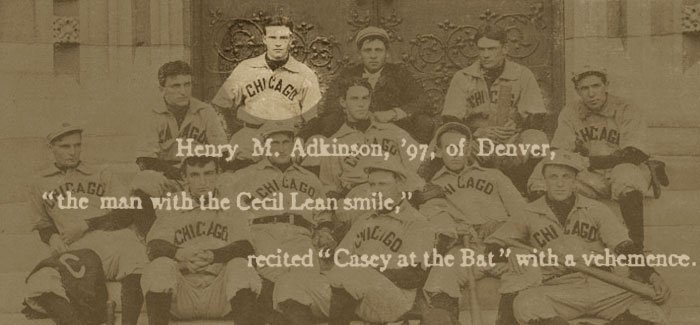
(Collage by Joy Olivia Miller using public domain archival images.)
Henry Adkinson, leading off
The incomplete history of the U of C’s first major league ballplayer.
The forgotten career of the first Maroon in the American major leagues ended as quickly as it began. On September 25, 1895, Henry Adkinson, AB 1897, AM 1898, took up his post in left field for the St. Louis Browns, kicking off the U of C’s start-and-stop history of professional athletics with the only nine innings he’d spend in the pros.
Baseball in the 1890s was not, certainly, as strictly governed as today’s leagues. In Adkinson’s era, picking up local ballplayers to fill roster holes on game day was still a regular practice; out of the 985 men with only one career game on record, less than half had their single major league cup of coffee in the modern (post-dead ball) era.
On this particular day, that’s probably what happened. The St. Louis Browns were scheduled for a doubleheader against the Cincinnati Reds. Behind the disastrous pitching of fellow one gamer Walter Coleman—12 earned runs, 12 hits, and eight walks—St. Louis lost 15–8 despite Adkinson acquitting himself well, with two singles and a run scored in five at bats. His lifetime .400 average, while impressive, is disqualified from leaderboards because of sample size. In the nightcap, the Browns responded with a 5–4 win behind their everyday starters.
The full account—why was Adkinson in St. Louis? Where were the regulars? What were the terms, and how did Adkinson feel about his accomplishment?—is probably buried for good; baseball historians can’t even fill Adkinson’s profile with his handedness, height, and weight.
It’s probably better that way. The specter of Adkinson’s one afternoon near the spotlight shouldn’t obscure the record of a life that appears, by all accounts, well lived. Born and raised in Chicago, Adkinson went on to earn his bachelor’s in 1897 and varsity honors on the U of C’s baseball team. For his thesis, “The Conception of Property Among North American Indians,” he was awarded a master’s in anthropology the next year. With his college sweetheart Inez Rice, AB 1898, Adkinson fathered two children, Henry Jr. and Margaret Adkinson, PhB’29. They moved to Denver; to Telluride, Colorado; and finally to Salt Lake City, Utah, where Adkinson died in 1923. He was well-known in the mining industry, owning and managing a series of gold and copper mines in which he introduced several new technical innovations. Adkinson’s business took him around the States, he and his wife entertained frequently, and he even served as the president of his children’s parent-teacher association.
Adkinson, a charter member of Chicago’s Alpha Delta Phi chapter, remained active in the U of C community. Along with several other original lettermen, he participated in laying the then–Bartlett Gymnasium’s cornerstone in 1902. He clocked in a shift as a representative of the Graduate School Council, and, at the 1911 Homecoming, Adkinson—labeled the “man with the Cecil Lean smile” in the Magazine’s coverage of the event, in reference to a period stage performer—recited the baseball poem “Casey at the Bat” with what his fellow alumni dubbed “a vehemence unsurpassed by DeWolf Hopper himself,” the actor best-known for his rendition of the poem.
You can’t quite say that Adkinson paved the way for future Maroons in the major leagues, but he certainly set a precedent. After Adkinson, the U of C reeled off four straight Big Ten titles in baseball under coach Amos Alonzo Stagg. Twelve other alumni went professional, including nine who made it to the pros: pitchers Roy Henshaw, X’33; Stan Baumgartner, APH 1914; and Fred “Mysterious” Mitchell Walker, APH 1906, PhB 1921, were the most successful. Perhaps Adkinson’s footnoted contribution to the history of Maroon athletics is more cornerstone than foundation.
